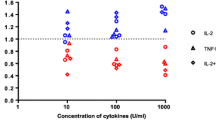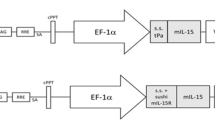Abstract.
Treatment of cancer by the administration of interleukin-2 (IL-2) at the tumour site is a very effective approach. The mechanism of this tumour regression is not clear, although it is generally assumed that it involves an IL-2-stimulated immune reaction. There are, however, no immune parameters that consistently correlate with the therapeutic effect. We have studied the histopathological events in a subcutaneously (s.c.) growing SL2 lymphosarcoma (transplantation of tumour cells at day 0) treated with peritumoural IL-2 injections at days 10–14. Most IL-2-treated tumours had already begun to regress from day 12 onwards, showing that local IL-2 therapy was also effective in the present study. The immediate reaction after local IL-2 administration is vascular leakage from the surrounding circulation, causing oedema within the tumour and in a broad zone surrounding it. The presence of oedema is always accompanied by markedly increased tumour necrosis. After a few days extensive angiogenesis occurs at the border between the oedematous area and the healthy connective tissue. Leucocytes, mainly macrophages, migrate via the newly formed blood vessels to gain access to the necrotising tumour site, where they form a granuloma. These macrophages phagocytose the dead tumour material. During growth, the SL-2 tumours infiltrate the surrounding tissue. The infiltrating tumour strands are apparently attacked by macrophages, as the tumour cells in close proximity to the latter are progressively destroyed. Therefore, the body of the tumour and the infiltrating tumour strands are attacked in different ways. The primary effect of IL-2 administration at the tumour site is vascular leakage that causes oedema in and around the tumour. This is followed by extensive angiogenesis, with the resulting migration of white cells from the circulation, which form a granuloma around the tumour. Both the oedema and the granuloma cause tumour regression.
Similar content being viewed by others
Author information
Authors and Affiliations
Additional information
Electronic Publication
Rights and permissions
About this article
Cite this article
Baselmans, A.H., Koten, JW., Battermann, J.J. et al. The mechanism of regression of solid SL2 lymphosarcoma after local IL-2 therapy. Cancer Immunol Immunother 51, 492–498 (2002). https://doi.org/10.1007/s00262-002-0306-2
Received:
Accepted:
Issue Date:
DOI: https://doi.org/10.1007/s00262-002-0306-2




